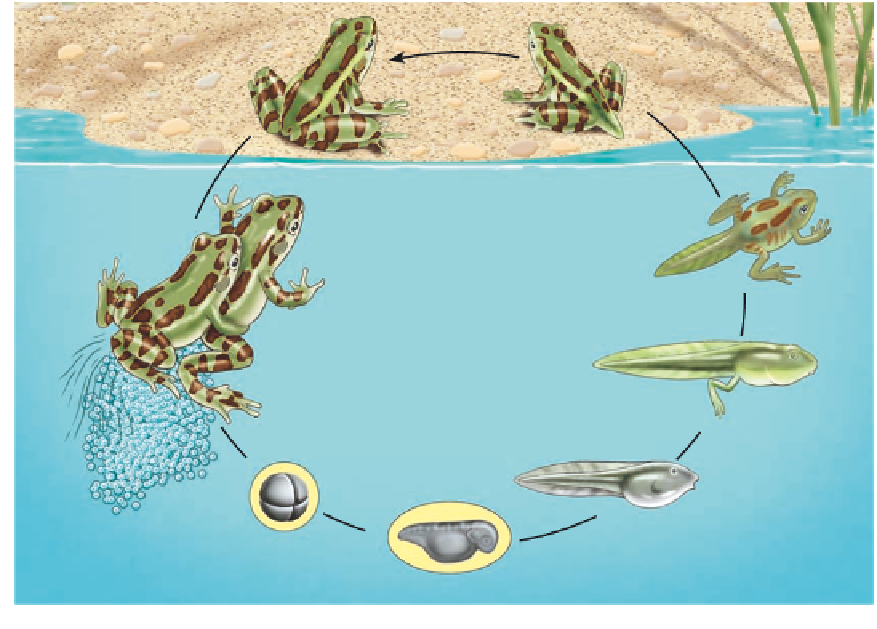Environmental Engineering Reference
In-Depth Information
Figure 6-3
Typical
life
cycle of a frog.
Popula-
tions of various frog
species can decline
because of the effects
of harmful factors at dif-
ferent points in their life
cycle. Such factors in-
clude habitat loss,
drought, pollution, in-
creased ultraviolet radi-
ation, parasitism, dis-
ease, overhunting for
food (frog legs), and
nonnative predators
and competitors.
Adult frog
(3 years)
Adult frog
(3 years)
Young frog
Young frog
Tadpole
develops
into frog
Sperm
Sexual
reproduction
Tadpole
Eggs
Fertilized egg
development
Egg hatches
Organ formation
■
Parasites
■
Overhunting
(especially in Asia and France, where
frog legs are a delicacy)
■
Viral and fungal diseases
■
Natural immigration or deliberate introduction of
nonnative predators and competitors
(such as fish) and
disease organisms
Keystone Species: Major Players
Keystone species help determine the types
and numbers of various other species in a
community.
A keystone is the wedge-shaped stone placed at the
top of a stone archway. Remove this stone and the arch
collapses. In some communities,
keystone species
serve a similar role. These species have a much larger
effect on the types and abundances of other species in
a community than their numbers would suggest. Elim-
inating a keystone species may dramatically alter the
structure and function of a community.
Keystone species play critical ecological roles. One
is
pollination
of flowering plant species by bees, hum-
mingbirds, bats, and other species. In addition,
top
predator
keystone species feed on and help regulate the
populations of other species. Examples are the wolf,
leopard, lion, alligator (Case Study, p. 108), and great
white shark (Case Study, right).
Have you thanked a
dung beetle
today? Perhaps you
should: These keystone species rapidly remove, bury,
and recycle dung. Without them, we would be up to our
eyeballs in animal wastes, and many plants would be
starved for nutrients. These beetles also churn and aer-
ate the soil, making it more suitable for plant life.
The loss of a keystone species can lead to popula-
tion crashes and extinctions of other species that de-
pend on it for certain ecological services. According to
biologist Edward O. Wilson, “The loss of a keystone
species is like a drill accidentally striking a power line.
It causes lights to go out all over.”
Why should we care if various amphibian species
become extinct? Scientists give three reasons.
First,
this
trend suggests that environmental health is deteriorat-
ing in parts of the world because amphibians are sensi-
tive biological indicators of changes in environmental
conditions such as habitat loss and degradation, pollu-
tion, UV exposure, and climate change.
Second,
adult amphibians play important ecologi-
cal roles in biological communities. For example, am-
phibians eat more insects (including mosquitoes) than
do birds. In some habitats, extinction of certain am-
phibian species could lead to extinction of other
species, such as reptiles, birds, aquatic insects, fish,
mammals, and other amphibians that feed on them or
their larvae.
Third,
amphibians represent a genetic storehouse
of pharmaceutical products waiting to be discovered.
Compounds in secretions from amphibian skin have
been isolated and used as painkillers and antibiotics
and as treatment for burns and heart disease.
The plight of some amphibian indicator species is
a warning signal. They may not need us, but we and
other species need them.










